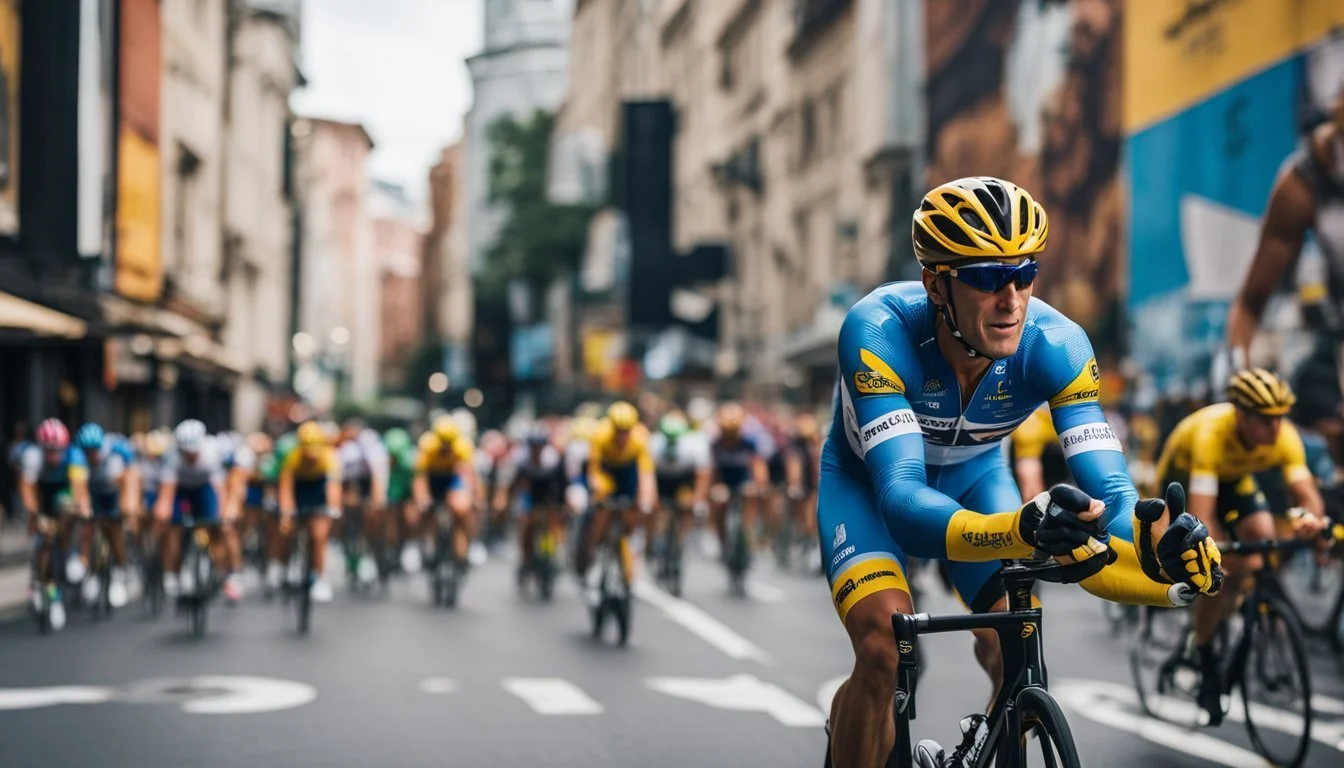Lance Armstrong's Legacy: Examining Austin's Ongoing Ethical Debate in Sports
Lance Armstrong's story is a complex tapestry of triumph and scandal, particularly for Austin, Texas, a city that played an integral role in his career and philanthropy. Once a near-mythic cycling figure and cancer survivor, Armstrong's fall from grace left indelible marks on both his personal reputation and the organizations he championed. Livestrong, the cancer-support charity he founded, saw its public image and support waver as Armstrong's doping scandal unfolded, raising enduring questions about the intersection of ethics and success in sports.
In Austin, the discourse around Armstrong’s legacy is intense and multifaceted. Some residents remember him as a local hero whose efforts brought global attention to issues like cancer survivorship and athletic excellence. Others view him through the lens of his deceit and the resultant tarnishing of the integrity of competitive cycling.
Today, Armstrong continues to navigate his way through this mixed legacy, engaging in charity work and cautiously re-entering public life. As Austin looks back on his career, the discussions increasingly center on broader themes of accountability, redemption, and the ethical responsibilities of public figures.
The Rise of Lance Armstrong
Lance Armstrong's ascent in the world of cycling was nothing short of spectacular. Overcoming significant personal challenges, he emerged as a dominant force, inspiring millions globally through his remarkable achievements and sheer perseverance.
From Survivor to Champion
Lance Armstrong's journey began in 1996, when he was diagnosed with advanced testicular cancer. Despite the grim prognosis, Armstrong underwent aggressive treatment, including surgery and chemotherapy. His recovery was marked by determination, which saw him return to professional cycling against all odds. This resilience not only made him a survivor but also a symbol of hope for other cancer patients. Armstrong’s story of beating cancer resonated deeply, turning him into a champion in the eyes of many, both on and off the bike.
Lance Armstrong and the Tour de France
From 1999 to 2005, Lance Armstrong secured seven consecutive victories at the Tour de France. This unprecedented achievement positioned him as one of the greatest cyclists of all time. His dominance in one of the world's most grueling sporting events showcased his exceptional athletic skills and unparalleled determination. The Tour de France titles were a testament to his rigorous training, strategic prowess, and relentless pursuit of excellence. These victories elevated Armstrong to international stardom, making his name synonymous with endurance and triumph.
The International Impact on Cycling
Armstrong's successes had a significant influence on the global perception of cycling. His victories brought increased visibility to the sport, attracting new fans, sponsors, and young athletes inspired by his story. Internationally, he became a figurehead, impacting cycling politics and culture. His foundation, established to support cancer survivors, further solidified his legacy. Worldwide, Armstrong's journey from a cancer patient to a cycling legend inspired many, fostering a deeper appreciation and awareness of both the sport and medical resilience.
Foundations and Philanthropy
Lance Armstrong's foray into philanthropy, particularly through the Livestrong Foundation, transformed the landscape of cancer support services. This section delves into key aspects such as its inception, impactful programs, grants, partnerships, and sponsorships.
The Launch of Livestrong
In 1997, cancer survivor Lance Armstrong established the Lance Armstrong Foundation, later rebranded as the Livestrong Foundation. The foundation's mission focused on providing support for individuals affected by cancer. One of its most iconic initiatives was the release of the Livestrong bracelets by Nike, which symbolized hope and raised significant funds. The distinct yellow bands became a global phenomenon, raising awareness and generating millions in donations.
Impactful Programs and Grants
Livestrong Foundation initiated numerous programs aimed at improving the quality of life for cancer survivors. They provided practical advice, emotional support, and resources for patients and their families. The foundation also distributed grants to scientific research and community support initiatives. These grants have funded groundbreaking research and bolstered local cancer support infrastructure, making a significant impact on many lives.
Partnerships and Sponsorships
Key partnerships and sponsorships played a crucial role in Livestrong's growth. Major corporations like Nike were instrumental in the early success of the foundation, not only through financial support but also through global awareness campaigns. The yellow Livestrong branded products cemented the organization's identity. Additionally, collaborations with other nonprofits and community groups helped expand their reach and effectiveness, ensuring that the support provided was both widespread and substantial.
Ethical Disputes and Doping Allegations
Lance Armstrong's enduring impact on cycling and sports ethics continues to spark debate. His legacy intertwines triumphs with notable ethical violations, highlighted by systematic use of banned substances and subsequent fallout.
Uncovering the Use of Banned Substances
Lance Armstrong's career spanned from overcoming testicular cancer to achieving seven consecutive Tour de France victories between 1999 and 2005. His triumphs, however, were clouded by persistent doping allegations. Investigations revealed his use of illegal performance-enhancing drugs, notably EPO (Erythropoietin), to enhance endurance and performance.
Blood tests and anti-doping measures eventually provided evidence of Armstrong's doping practices. Investigations by the U.S. Anti-Doping Agency in 2012 confirmed the extent of his use of banned drugs. This systematic doping scheme involved sophisticated methods to evade detection, demonstrating a significant breach of both ethical standards and sporting regulations.
Confession and Repercussions
Armstrong's fall from grace became public during a 2013 interview with Oprah Winfrey. He admitted to using performance-enhancing drugs to achieve his victories, a confession that resonated worldwide. The ensuing backlash was substantial. Armstrong was stripped of his seven Tour de France titles and banned from professional cycling for life.
The repercussions extended beyond personal penalties. His case highlighted flaws in anti-doping enforcement and sparked widespread scrutiny and reforms within the sport. Armstrong's legal battles, including lawsuits from sponsors and organizations, further damaged his reputation. These events fundamentally altered public perception, framing Armstrong not only as a cycling legend but also as a symbol of ethical failure in sport.
Livestrong’s Evolution and Armstrong's Departure
Livestrong's journey has been significantly shaped by both its remarkable growth as a cancer charity and the profound impact of Lance Armstrong's departure. The changes and restructurings reflect efforts to preserve its mission amid challenges.
Restructuring and Rebranding Efforts
After Armstrong resigned as chairman of the Lance Armstrong Foundation, the organization undertook major restructuring and rebranding efforts. By distancing itself from its founder, the nonprofit organization sought to restore credibility and trust. The board and leadership initiated strategic shifts, emphasizing a broadened scope beyond its association with Armstrong.
The brand was crucially rebranded to focus on the Livestrong mission rather than its initial celebrity backing. Fundraising strategies evolved, and new partnerships were formed to diversify revenue streams. These moves aimed to solidify Livestrong’s position in the nonprofit sector, ensuring its survival amidst a storm of controversy.
Continued Mission for Cancer Support
Despite leadership changes, Livestrong's core mission of supporting cancer survivors continued unabated. The organization reaffirmed its dedication to cancer research, survivorship programs, and awareness campaigns. Livestrong cancer institutes were established, offering cutting-edge treatment and support for patients and survivors.
Livestrong's initiatives included funding educational resources, supporting community-based projects, and investing in innovative cancer research. The organization's steadfast focus on survivorship ensured that its impact remained significant, providing valuable resources and advocacy for cancer patients worldwide. Through these efforts, Livestrong maintained its commitment to assisting those affected by cancer, reinforcing its relevance and value.
Cultural and Community Influence
Lance Armstrong's influence on Austin and its community extends beyond his controversial career, impacting local cycling culture and infrastructure. This section explores how Austin embraced cycling, partly due to Armstrong, and examines the significant landmarks attributed to his legacy.
Austin's Embrace of Cycling Culture
Austin, Texas, has long been known for its vibrant culture and active lifestyle. The city's embrace of cycling is partly due to Lance Armstrong's prominence. His success brought attention to the sport, inspiring many residents to take up cycling.
Armstrong's affiliation with Mellow Johnny's, a popular bike shop in downtown Austin, further reinforced cycling as a key part of the local culture. The shop became a hub for both avid cyclists and beginners, offering gear, repairs, and community events. This local hotspot played a pivotal role in promoting cycling and fostering a strong community spirit around the sport.
Additionally, Armstrong's influence extended to numerous cycling events in Austin. Regular races and charity rides, many organized by the Livestrong Foundation, attract cyclists from across the country, strengthening the city's reputation as a cycling haven. Austin American-Statesman, the local newspaper, often covers these events, highlighting their importance to the community and the city's dedication to supporting an active lifestyle.
Lance Armstrong Bikeway and Commemoration
The Lance Armstrong Bikeway, a significant infrastructure project in Austin, symbolizes Armstrong's lasting impact on the city. This dedicated cycling path spans several miles, connecting key parts of the city and providing safe, accessible routes for cyclists.
The bikeway represents Armstrong's commitment to promoting a healthy lifestyle and advocating for better cycling infrastructure. By creating a safer environment for cyclists, the bikeway encourages more residents to consider cycling as a viable mode of transportation and recreation.
Commemorations of Armstrong's influence are also evident in community initiatives and public art. The bikeway's development was often accompanied by community events celebrating Armstrong's achievements, despite his later controversies. These instances underline his complex legacy in Austin, highlighting both his contributions to cycling and the continuing discourse around sporting ethics.
By bridging various parts of the city, the Lance Armstrong Bikeway remains a testament to the enduring cultural and community influence he has had on Austin, fostering both a shared passion for cycling and an ongoing dialogue about integrity in sports.
Reflections on an Iconic Figure
Lance Armstrong's legacy prompts diverse considerations ranging from his impact on public perception to academic analysis. Both angles provide a comprehensive look at his significance in sports and society.
Legacy Considerations and Public Perception
Lance Armstrong's celebrity status peaked during his seven Tour de France victories, which later faced scrutiny due to doping revelations. Public sentiment shifted dramatically, transforming Armstrong from an iconic hero to a controversial figure. The term "Shakespearean tragedy" is often referenced, highlighting the dramatic rise and fall of his career.
Residents of Austin, where Armstrong's influence is tangible, have mixed views. Some appreciate his contributions to cancer awareness and local businesses like the Juan Pelota Café and Mellow Johnny's bike shop. Others grapple with the ethical implications of his actions and their broader impact on the cycling world.
Academic Perspectives and Analytical Views
Academic analysis of Armstrong's legacy often focuses on the implications of his actions for sporting ethics. Sam Burns, a Ph.D. student at the School of Information, examines how his story influences public trust in sports. Kirk Bohls, a noted sports columnist, discusses the complexities of Armstrong's narrative and its representation in media.
Studies also explore the psychological and societal factors that enabled Armstrong's actions, providing a nuanced understanding of his motivations and their consequences. By dissecting these elements, academia paints a multifaceted picture of Armstrong, balancing his athletic successes with the ethical dilemmas he embodies.
The Ongoing Debate in Sporting Ethics
Lance Armstrong's legacy continues to fuel discussions about sporting ethics, reputation, and trust. These debates are spurred by his doping scandal and its impact on the cycling world and beyond.
The Broader Implications of Armstrong's Actions
Armstrong's use of performance-enhancing drugs, revealed through his confession and substantiated by his former teammates Floyd Landis and Tyler Hamilton, raises critical questions about athletic integrity. His seven-time Tour de France titles, stripped after the truth surfaced, symbolize a broader issue of trust in professional sports.
Local institutions like the University of Texas, where Armstrong has deep ties, face ethical quandaries regarding their associations with him. Similarly, SCA Promotions, involved in legal battles over his bonuses, exemplifies financial and moral repercussions.
Nationally, his case reached federal grand juries and prosecutors in Los Angeles, illustrating the severe legal stakes. Major media outlets like CBS's 60 Minutes highlighted the controversy, amplifying public scrutiny. Despite his apology, the ongoing debates underscore the lasting impact of his actions on sporting ethics.






